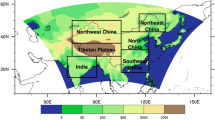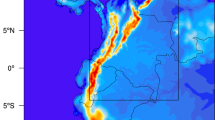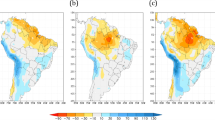Abstract
Spatially precise forecasts of the impacts of climate change on the distribution of major vegetation types are essential for the implementation of effective conservation and land use policy. However, existing studies frequently omit major sources of climate variability that can significantly increase the uncertainty of projections. In this study we demonstrate how different predictions for sea surface temperature (SST) for the first half of the twenty-first century increase the uncertainty associated with forecasts of the future distribution of major ecosystems in South America. This is demonstrated through a numerical experiment using a coupled climate–vegetation model (CCM3-IBIS) for IPCC emission scenario A2 that incorporates the SST data from ten different models. The study reveals an increasing uncertainty in the ability to forecast future vegetation patterns, such that by 2050 the simulation is unable to robustly forecast the vegetation cover in an area equivalent to 28 % in South America (5 × 106 km2). The future of the central and northeastern regions of Brazil is especially uncertain, with outcomes, ranging from savanna, and open shrubland to grassland. Recognizing and managing such uncertainty should be a priority for decision makers.





Similar content being viewed by others
References
Alo CA, Wang G (2008) Potential future changes of the terrestrial ecosystem based on climate projections by eight general circulation models. J Geophys Res 113:G01004. doi:10.1029/2007JG000528
Barsugli JJ, Shin SI, Sardeshmukh PD (2006) Sensitivity of global warming to the pattern of tropical ocean warming. Clim Dyn 27:483–492
Betts RA, Cox PM, Lee SE, Woodward FI (1997) Contrasting physiological and structural vegetation feedbacks in climate change simulations. Nature 387:796–799
Betts RA, Cox PM, Collins M, Harris PP, Huntingford C, Jones CD (2004) The role of ecosystem-atmosphere interactions in simulated Amazonian precipitation decrease and forest dieback under global climate warming. Theor Appl Climatol 78:157–175
Cook KH, Vizy EK (2008) Effects of twenty-first-century climate change on the Amazon rain forest. J Clim 21:542–560
Cox PM, Betts RA, Jones CD, Spall SA, Totterdell IJ (2000) Acceleration of global warming due to carbon-cycle feedbacks in a coupled climate model. Nature 408:184–187
Cox PM, Betts RA, Collins M, Harris PP, Huntingford C, Jones CD (2004) Amazonian forest dieback under climate-carbon cycle projections for the 21st century. Theor Appl Climatol 78:137–156
Delire C, Levis SL, Bonan G, Foley JA, Coe MT, Vavrus S (2002) Comparison of the climate simulated by the CCM3 coupled to two different land-surface models. Clim Dyn 19:657–669
Diaz AF, Studzinski CD, Mechoso CR (1998) Relationships between precipitation anomalies in Uruguay and Southern Brazil and sea surface temperature in the Pacific and Atlantic Oceans. J Clim 11(2):251–271
Field CB, Jackson RB, Mooney HA (1995) Stomatal responses to increased CO2: implications from the plant to the global scale. Plan, Cell Environ 18:1214–1225
Foley JA, Prentice IC, Ramankutty N, Levis S, Pollard D, Sitch S, Haxeltine A (1996) An integrated biosphere model of land surface processes, terrestrial carbon balance, and vegetation dynamics. Global Biogeochem Cycles 10:603–628
Fu R, Dickinson RE, Chen M, Wang H (2001) How do tropical sea surface temperatures influence the seasonal distribution of precipitation in the equatorial Amazon? J Clim 14(20):4003–4026
Grimm AM, Barros VR, Doyle ME (2000) Climate variability in Southern South América associated with El Niño and La Niña events. J Clim 13:35–58
Haylock MR, Peterson TC, Alves LM, Ambrizzi T, Anunciação YMT, Baez J, Barros VR, Berlato MA, Bidegain M, Coronel G, Corradi V, Garcia VJ, Grimm AM, Karoly D, Marengo JA, Marino MB, Moncunill DF, Nechet D, Quintana J, Rebello E, Rusticucci M, Santos JL, Trebejo I, Vincent LA (2006) Trends in total and extreme South Américan rainfall in 1960–2000 and links with sea surface temperature. J Clim 19:1490–1512
Huffman GJ et al (1997) The Global Precipitation Climatology Project (GPCP) combined precipitation dataset. Bull Am Meteorol Soc 78:5–20
Kalnay E et al (1996) The NCEP/NCAR 40-year reanalysis project. Bull Am Meteorol Soc 77:437–471
Kiehl JT, Hack JJ, Bonan GB, Boville BA, Williamson DL, Rasch PJ (1998) The National Center for Atmospheric Research Community Climate Model: CCM3. J Clim 11(6):1131–1149
Kucharik CJ, Foley JA, Delire C, Fisher VA, Coe MT, Lenters JD, Young-Molling C, Ramankutty N (2000) Testing the performance of a dynamic global ecosystem model: water balance, carbon balance, and vegetation structure. Global Biogeochem Cycles 14:795–825
Lapola DM, Oyama MD, Nobre CA (2009) Exploring the range of climate biome projections for tropical South America: The role of CO2 fertilization and seasonality. Global Biogeochem. Cycles 23:GB3003. doi:10.1029/2008GB003357
Levis S, Foley JA, Pollard D (2000) Large scale vegetation feedbacks on a doubled CO2 climate. J Clim 13(7):1313–1325
New M, Hume M, Jones P (1999) Representing twentieth century space–time climate variability: 1. Development of a 1961–1990 mean monthly terrestrial climatology. J Clim 12:829–856
Nobre P, Shukla J (1996) Variations of sea surface temperature, wind stress, and rainfall over the Tropical Atlantic and South América. J Clim 9(10):2464–2479
Rammig A, Jupp T, Thonicke K, Britta T, Heinke J, Ostberg S, Lucht W, Cramer W, Cox P (2010) Estimating the risk of Amazonian forest dieback. New Phytol. doi:10.1111/j.1469-8137.2010.03318.x
Salazar LF, Nobre CA, Oyama MD (2007) Climate change consequences on the biome distribution in tropical South America. Geophys Res Lett 34:L09708
Sellers PJ, Bounoua L, Collatz GJ, Randall DA, Dazlich DA, Los SO, Berry JA, Fung I, Tucker CJ, Field CB, Jensen TG (1996) Comparison of radiative and physiological effects of doubled atmospheric CO2 on climate. Science 271(5254):1402–1406
Senna MCA, Costa MH, Pinto LIC, Imbuzeiro HMA, Diniz LMF, Pires GF (2009) Challenges to reproduce vegetation structure and dynamics in Amazonia using a coupled climate-biosphere model. Earth Interact. doi:10.1175/2009EI281.1
Uppala SM et al (2005) The ERA-40 re-analysis. Q J R Meteorolog Soc 131:2961–3012
Willmott CJ, Matsuura K (2001) Terrestrial air temperature and precipitation: monthly and annual time séries (1950–1999). Center for climate research version 1.02
Woodward MRL, Kelly CK (2004) Global climate and the distribution of plant biomes. Philos Trans Roy Soc London 359B:1465–1476
Xie P, Arkin PA (1997) Global precipitation: a 17-year monthly analysis based on gauge observations, satellite estimates, and numerical model outputs. Bull Am Meteorol Soc 78:2539–2558
Acknowledgments
We acknowledge the financial support by the Amazonas and Minas Gerais State Research Funding Agencies (FAPEAM, FAPEMIG), and the Gordon and Betty Moore Foundation. The paper was read and edited by Dr. Richard Ladle, Oxford University.
Author information
Authors and Affiliations
Corresponding author
Rights and permissions
About this article
Cite this article
Pereira, M.P.S., Costa, M.H. & Malhado, A.C.M. Vegetation patterns in South America associated with rising CO2: uncertainties related to sea surface temperatures. Theor Appl Climatol 111, 569–576 (2013). https://doi.org/10.1007/s00704-012-0683-1
Received:
Accepted:
Published:
Issue Date:
DOI: https://doi.org/10.1007/s00704-012-0683-1




